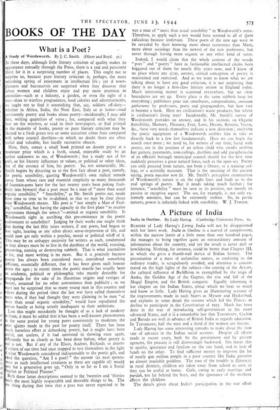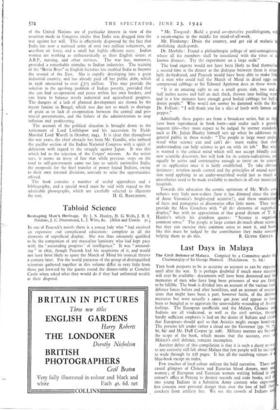A Picture of India
India in Outline. By Lady Hartog. (Cambridge University Prcss. 6s.
READERS of Lady Hartog's Living India will not be disappointed with her latest work. India in Outline is a marvel of compression; within the narrow limits of a little more than one hundred pages, she manages to bring together quite an extraordinary amount oi information about the country, and yet the result is never dull or bewildering. Nothing, for instance, could be better than Chapter III, in which she gives a thumb-nail sketcn of Indian history. The presentation of a mass of unfamiliar names, so confusing to the ordinary reader, is scrupulously avoided, and attention is concen- trated on the high lights of the subject—the coming of the Aryans, the cultural influence of Buddhism as exemplified by the reign of Asoka, the Golden Age of the Guptas, the rise and fall of the Mogul Empire, and the British conquest. Equally informing is her chapter on the Indian States, about which we hear so much and know so little. Lady Hartog gives an illuminating account of the improvements made in such States as Mysore and Hyde:Thad, and explains in some detail the icasons which led the Princes to decline to participate in the Constitution of 1935. Much has been done in the way of introducing self-governmcnt in the more advanced States, and it i a remarkable fact that Travancore, Cochin and Baroda are well in advance of British India as regards education. In Travancore, half the men and a third of the women are literate.
Lady Hartog has some interesting remarks to make about the slow !ate of advance in the Indian social services. Despite all efforts made in recent years, both by the government and by private agencies, the peasant is still distressingly backward. She traces this to apathy, ignorance and fatalism on the one hand, and to lack of funds on the other. To find sufficient money to improve the lot of nearly 4co million people in a poor country like India presents an almost insoluble problem. The root of the trouble is illiteracy; in rural districts, children are taken away from school as soon as they can be useful at home. Girls, owing to early marriage and purdah, are far behind the boys, and the ignorance of the mothers affects the children.
The details given about India's participation in the war effort
of the United Nations are of particular interest in view of the assertion made in Congress circles that India was dragged into the war against her will. This is effectively disproved by the fact that India has now a national army of over two million volunteers, an excellent air force, and a small but highly efficient navy. Indian women are working as enthusiastically as their English sisters at A.R.P., nursing, and other services. The war has, moreover, provided a remarkable stimulus to Indian industries. The training of the "Bevin Boys" in English factories has enabled India to become the arsenal of the East. She is rapidly developing into a great industrial country, and has already paid off her public debt, which in 1936 amounted to over £375 million. This may provide the solution to the age-long problem of Indian poverty, provided that she can find co-operation and peace within her own borders, and can learn to balance wisely industrial and agricultural progress. The dangers of a lack of planned development are shown by the recent famine in Bengal, which was due not so much to shortage of grain as to lack of co-operation between the central and pro- vincial governments, and the failure of the administration to stop inflation and profiteering.
The account of the political situation is brought down to the retirement of Lord Linlithgow and his succession by Field- Marshal Lord Wavell in October, 1943. It is clear that throughout the war years, the chief obstacle has been Mr. Gandhi, who imbued the pacifist section of the Indian National Congress with a spirit of defeatism with regard to the struggle against Japan. It was this which led to the rejection of the Cripps' mission. As the writer says, it seems an irony of fate that while previous steps on the road to self-government came too late to satisfy nationalist India, the proposals for the final transfer of power found Indians, owing to their own internal divisions, unready to seize the opportunities offered.
The book contains a number of useful appendices and a bibliography, and a special word must be said with regard to the admirable photographs, which are carefully selected to illustrate























 Previous page
Previous page